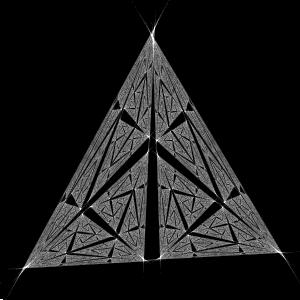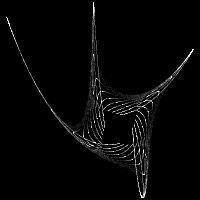
Aléatoire, 2 fonctions

Aléatoire retravaillé, 2 fonctions

Fougère, 3 fonctions

Exploration, 2 fonctions

Construit, 7 fonctions

Aléatoire, 3 fonctions

[esperanto] [français] [english]
Copyright © 1996, 2002, 2003 Emmanuel Debanne (emmanuel (a) debanne . net)
Nova! RPM por Glito 1.1
Tiu programo estas eldonata laŭ la GNUa Ĝenerala Publika Permesilo. Ĝi uzas la bibliotekon FLTK (www.fltk.org).
[Priskribo] [Elŝuti] [Instali] [Uzindikoj] [Ekzemplejo] [Ligoj]
Glito estas publikaĵo por eksplori la dudimensiajn IFS-ajn fraktalojn (Iterated Function System).
IFS-aj fraktaloj estas konstruataj per kalkulado de la iteraciaj bildoj de punkto per afinaj funkcioj. IFSo estas konstituata de n (n ≥ 2) afinaj funkcioj. Iteracia punkto estas bildo de punkto per hazarde elektita funkcio de la IFS.
Glito povas uzi la afinajn funkciojn:
Xn+1 = x1 Xn
+ x2 Yn + xc
Yn+1 = y1 Xn
+ y2 Yn + yc
kaj la sinusoidajn funkciojn:
Xn+1 = x1 cos(Xn)
+ x2 sin(Yn) + xc
Yn+1 = y1 sin(Xn)
+ y2 cos(Yn) + yc
Glito servas ankaŭ por desegni Julia-aĵojn. Teorike sufiĉas kalkuli la punktojn difinitajn per la vico:
Zn+1 = √( Zn - c )
kun c la parametro de la Julia-a fraktalo. En Glito,
la ekvacio estas ŝanĝeta por helpi la manipuladon kaj por uzi la
linearajn funkciojn. Oni difinas, kun Zn = Xn +
i Yn kaj c = xc + i yc:
Zn+1 = √( x1 Xn + x2 Yn + i (y1 Xn + y2 Yn) + c² )
En Glito, funkcioj estas figurataj per paralelogramoj de centro la punkto (xc, yc) kaj kies du sinsekvaj strekoj estas la vektoroj (x1, y1) kaj (x2, y2).
Funkcioj:
La netradukita programo, la uzindikoj kaj la ekzemploj de IFS estas
en densigita dosiero "tar.gz":
glito-1.1.tar.gz
Por Vindozo, la sama dosiero kun plie la maŝinlingva programo
nomita "glito.exe":
glito-1.1.zip
Maldensigi la zip-aĵon kaj lanĉi glito-eo.bat.
Por profiti de la MNG-aj strukturoj kun Glito, vi bezonas la bibliotekon "libmng" (http://www.libmng.com).
Se la biblioteko FLTK ne estas instalita en via sistemo, prenu ĝin el www.fltk.org en la menuero "Software". Elektu la eldonon fltk-1.1.xxx kun xxx ajna. Instalu ĝin:
$ tar zxvf fltk-1.1.xxx.tar.gz $ cd fltk-1.1.xxx $ ./configure $ make $ su $ make install
Kiam la biblioteko FLTK estas instalita, vi povas instali Gliton:
$ tar zxvf glito-xxx.tar.gz $ cd glito-xxx $ ./configure $ make $ su $ make install $ glito
Komentoj, sugestoj kaj kontribuaĵoj estas bonvenataj!
Ce programme est placé sous la Licence Public Générale GNU. Il utilise la bibliothèque FLTK (www.fltk.org).
[Description] [Télécharger] [Installer] [Manuel d'utilisation] [Gallerie] [Liens]
Glito est un logiciel libre permettant d'explorer les fractales IFS (Iterated Function System) de dimension 2.
Les IFS sont construits en calculant les images successives d'un point par des applications affines contractantes. A chaque IFS correspond n (n ≥ 2) applications affines. Pour chaque nouvelle image d'un point, on choisit au hasard l'une des applications affines.
Glito gère les applications affines :
Xn+1 = x1 Xn
+ x2 Yn + xc
Yn+1 = y1 Xn
+ y2 Yn + yc
et les fonctions sinusoidales :
Xn+1 = x1 cos(Xn)
+ x2 sin(Yn) + xc
Yn+1 = y1 sin(Xn)
+ y2 cos(Yn) + yc
Glito peut également tracer les ensembles de Julia. Théoriquement, il suffit de tracer les itérés de la suite :
Zn+1 = √( Zn - c )
où c est le paramètre du Julia. Dans
Glito, l'équation est modifiée pour rendre la
manipulation plus intuitive et pour profiter des applications
linéaires. On définit, avec Zn =
Xn + i Yn et c = xc + i
yc :
Zn+1 = √( x1 Xn + x2 Yn + i (y1 Xn + y2 Yn) + c² )
Avec Glito, les fonctions sont représentées par des parallélogrammes dont le centre a pour coordonnées (xc, yc) et dont deux côtés contigus correspondent aux vecteurs (x1, y1) et (x2, y2).
Fonctionnalités :
Le code source, le manuel et des exemples d'IFS sont disponibles dans
un tar.gz :
glito-1.1.tar.gz
Pour Windows, le même archive mais avec un binaire
déjà compilé pour Windows appelé
«glito.exe» :
glito-1.1.zip
Dézipper et lancer glito-fr.bat.
Si vous voulez bénéficier du format MNG sous Glito, il vous faut la librairie libmng (http://www.libmng.com).
Si la librairie FLTK n'est pas installée sur votre système, obtenez-la sur www.fltk.org dans la rubrique Software. Prenez la version fltk-1.1.xxx avec xxx quelconque. Enfin, tapez :
$ tar zxvf fltk-1.1.xxx.tar.gz $ cd fltk-1.1.xxx $ ./configure $ make $ su $ make install
Une fois que la librairie FLTK est installée sur votre système, ceci devrait suffire:
$ tar zxvf glito-xxx.tar.gz $ cd glito-xxx $ ./configure $ make $ su $ make install $ glito
Merci de me faire connaître vos commentaires, suggestions ou contributions.
This software is provided under the terms of the GNU General Public License. Glito is based in part on the work of the FLTK project (www.fltk.org).
[Description] [Download] [Install] [Manual] [Gallery] [Links]
Glito is free software. It is an explorer of IFS (Iterated Function Systems) in 2D. IFS are a type of fractals. They are built by calculating the iterated images of a point by contractive affine mappings. An IFS is a set of n (n ≥ 2) functions. A function is chosen randomly to give a new image of a point.
Glito deals with linear functions:
Xn+1 = x1 Xn
+ x2 Yn + xc
Yn+1 = y1 Xn
+ y2 Yn + yc
and sinusoidal functions:
Xn+1 = x1 cos(Xn)
+ x2 sin(Yn) + xc
Yn+1 = y1 sin(Xn)
+ y2 cos(Yn) + yc
Glito can be used to draw Julia sets as well. Theorically we just need to draw the points defined by:
Zn+1 = √( Zn - c )
where c is the parameter of the Julia. In Glito the
equation is modified to make the manipulation easier and to benefite
from the linear mappings. We define, with Zn =
Xn + i Yn and c = xc +
i yc:
Zn+1 = √( x1 Xn + x2 Yn + i (y1 Xn + y2 Yn) + c² )
Glito represents a function by a parallelogram. The center of the parallelogram has for coordinates (xc, yc) and two contiguous edges correspond to the vectors (x1, y1) and (x2, y2).
Glito's features:
Source code, manual and exemples of IFS are in the following
tar.gz:
glito-1.1.tar.gz
For Windows, you can download the same archive with an already
compiled binary for this platform called "glito.exe":
glito-1.1.zip
Unzip and launch "glito-en.bat".
To benefit from MNG formats with Glito, install the MNG library (http://www.libmng.com).
If the FLTK library is not installed on your system, get it at www.fltk.org in the Software part. Download version fltk-1.1.xxx, whatever is xxx. Then type:
$ tar zxvf fltk-1.1.xxx.tar.gz $ cd fltk-1.1.xxx $ ./configure $ make $ su $ make install
Once the FLTK library is installed on your system, these commands shoud be sufficient:
$ tar zxvf glito-xxx.tar.gz $ cd glito-xxx $ make $ su $ make install $ glito
Comments, suggestions or contributions are welcome.
 Aléatoire, 2 fonctions |
 Aléatoire retravaillé, 2 fonctions |
 Fougère, 3 fonctions |
 Exploration, 2 fonctions |
 Construit, 7 fonctions |
 Aléatoire, 3 fonctions |
Réalisés avec seulement une fonction dont le parallélogramme est un carré centré en 0.
Realised with only one function whose parellelogram is a square centered on 0.
 |
 |
 |
V1 = (3,18; -1,03) |
V1 = (1,66; 0,81), sens indirect (determinant < 0) |
V1 = (1,81; 0,4) |
Provu la ekemploj de la dosierujo "glito-xxx/ifs"!
Essayez les exemples fournis avec Glito (dossier "ifs") !
Vidu kelkajn kreaĵojn de amiko: Visitez ce site réalisé avec Glito : Have a look to this page made with Glito: |

|
Angla lingve/en anglais :
Fractint : www.fractint.org
To explore the fractal world.
Spanky pages : spanky.fractint.org
Fractal related material.
IFS theory : Lecture
Notes of David J. Wright
Read the chapter about IFS of these Dynamical Systems and Fractals
Lecture Notes.